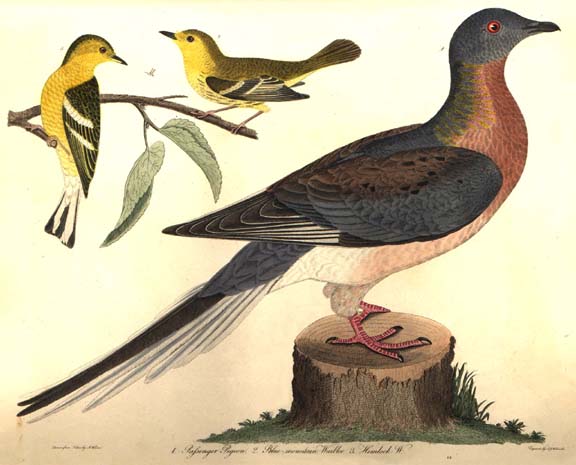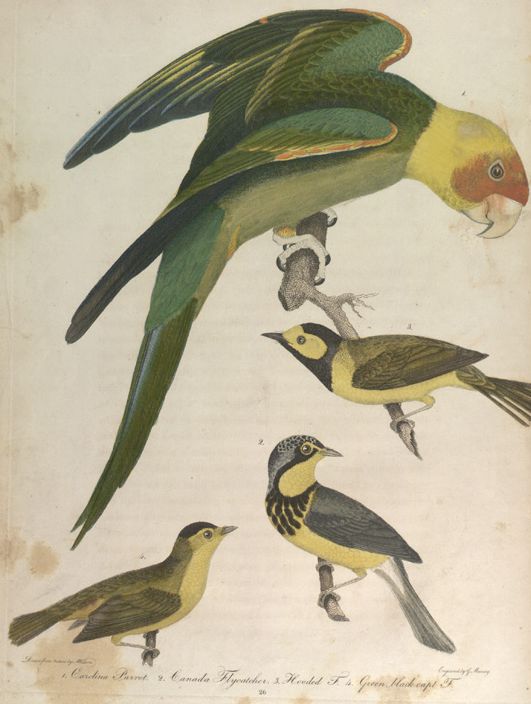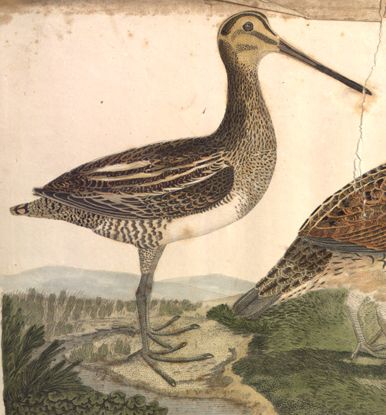we know from our own mr a wilson that the alexander wilson was a preeminent american ornithologist. what i didnt realize is that he was a skilled illustrator or birds as well. he is noted for the eight volume set posted here. first to find the wilson warbler wins.
i dont think the WW is included in those volumes so here :

hint : its not the carrier pigeon

Wilson didnít name birds after himself, that was done by later ornithologists in tribute. The plate above shows the three birds now grouped in genus wilsonia (ignore the Carolina Parakeet, it may be big and flashy but itís now extinct.) Wilsonís Warbler is at lower left, here called the Green Black-capt Flycatcher. To the right are the Hooded and Canada Flycatchers, which still bear those names today, except that we call them warblers, with flycatchers being a whole other, unrelated group. Bird names change as our understanding of them changes, but Wilson himself was a good taxonomist, a better scientist than Audubon, if not a better artist. One gratifying recent development in avian taxonomy is the return of Wilsonís Snipe (below) which had been lumped with the Old Worldís Common Snipe, until being re-split a few years back.

How much of bird taxonomy is traditional "these go together" and how much is pure DNA analysis?
from the the AW biography : Wilson also supplied most of the text that accompanied the drawings, a feat that seems almost insupportable from our modern vision of a scientist--for Wilson had no formal training, and in fact owned few books of his own. Thus, the writing that supports the drawings is that of a skilled and diligent observer. He notes the habits and habitats of birds as if they were companions rather than objects of study; his affection for his topic is decisively apparent. Decidedly, he is a naturalist rather than a scientist; because of his lack of formal training, he is free to make judgements and advance ideas that might otherwise have been unacceptable in a highly learned format. In April of 1807, Wilson wrote to Bartram:
"The more I read and reflect on the subject, the more dissatisfied I am with the specific names which have been used by almost every writer. A name should, if possible, be expressive of some peculiarity in colour, conformation or habit; if it will equally apply to two different species, it is certainly an improper one. Is migratorius an epithet peculiarly applicable to the robin? Is it not equally to so almost every species of turdis we have? Europea has been applied by Pennant to our large sitta or nuthatch, which is certainly a different species from the European, the latter being destitute of the black head, neck, and shoulders of ours. Latham calls it carolinensis, but it is as much an inhabitant of Pennsylvania and New York as Carolina. The small red-bellied sitta is called canadensis by Latham, a name equally objectionable with the other. Turdus minor seems also improper; in short, I consider this part of the business as peculiarly perplexing; and I beg to have your opinion on the matter, particularly with respect to the birds I have mentioned, whether I shall hazard a new nomenclature, or, by copying, sanction what I do not approve of."
It is worthwhile to note that "what I do not approve of" is almost entirely the work of European naturalists; in renaming the American birds he saw, Wilson claimed a sphere of nature that was neither repetitive nor inferior to Europe's, as had often been claimed by many Europeans, and eagerly refuted by such notables as Thomas Jefferson in his "Notes on the State of Virginia." Wilson saw his publication of the Ornithology as a deeply American venture, an act of patriotism that asserted the greatness and scope of his new country's resources.
DNA analysis is making inroads but ornithology is pretty much old-school, relying on direct field observation. Recent work suggests 15 new species for North America, but itíll take a while before the AOU makes them offical.
Birders trip out on this stuff, as species on your life list may multiply or disappear all together. For the hard-core thereís the Frontiers of ID list, mostly about gulls in the winter, but have heart, spring is happening, despite some resistance,,,
|
- bill 4-09-2007 8:50 pm
i dont think the WW is included in those volumes so here :

hint : its not the carrier pigeon
- bill 4-09-2007 9:20 pm [add a comment]
Wilson didnít name birds after himself, that was done by later ornithologists in tribute. The plate above shows the three birds now grouped in genus wilsonia (ignore the Carolina Parakeet, it may be big and flashy but itís now extinct.) Wilsonís Warbler is at lower left, here called the Green Black-capt Flycatcher. To the right are the Hooded and Canada Flycatchers, which still bear those names today, except that we call them warblers, with flycatchers being a whole other, unrelated group. Bird names change as our understanding of them changes, but Wilson himself was a good taxonomist, a better scientist than Audubon, if not a better artist. One gratifying recent development in avian taxonomy is the return of Wilsonís Snipe (below) which had been lumped with the Old Worldís Common Snipe, until being re-split a few years back.
- alex 4-10-2007 5:04 am [add a comment]
How much of bird taxonomy is traditional "these go together" and how much is pure DNA analysis?
- mark 4-10-2007 9:29 am [add a comment]
from the the AW biography :
- bill 4-10-2007 3:21 pm [add a comment]
DNA analysis is making inroads but ornithology is pretty much old-school, relying on direct field observation. Recent work suggests 15 new species for North America, but itíll take a while before the AOU makes them offical.
Birders trip out on this stuff, as species on your life list may multiply or disappear all together. For the hard-core thereís the Frontiers of ID list, mostly about gulls in the winter, but have heart, spring is happening, despite some resistance,,,
- alex 4-11-2007 5:07 am [add a comment]